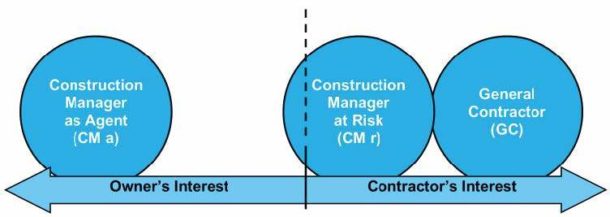The Guild Master

Over the last 70 years or so, many forces have been applied to the construction industry to fragment and specialize the process.
These forces have been both externally applied and self-imposed. Owners are always looking for a better way to purchase and improve the final product, while minimizing their risk and realizing best value.
As the construction industry evolves, there have been a host of changes in how projects are delivered (managed and contracted). And, to further complicate the process, there is confusion over terminology. Often terms like Design/Build (D/B), Integrated Project Delivery (IPD), CM as Advisor (CMa) and CM at Risk (CMr) are used interchangeably. While interchangeability of these terms may be sufficient for the layperson, most sophisticated Owners understand the subtleties between these delivery methods. Usually, one-time buyers of design and construction services do not.
We have found that this confusion over terminology gets in the way of what we believe to be the best way to deliver projects: put one firm in charge of the project and expect them to deliver design and construction activity as the Owner’s advocate. This article is meant to provide the reader with an understanding of the key differences between each method. The impact of overlaying a Construction Manager as Agent (CMa) to the IPD method will also be discussed as the hybrid that gives the Owner the best value and protection of their interests.
At its simplest, the main difference between D/B and IPD is the contractual arrangement between the parties. In D/B the Owner hires the Builder and the Builder hires the Architect. For the Owner, this arrangement begs the question…“who is the architect working for…me or the builder?”
Contractually the IPD method has numerous variations, but the Owner holds either all contracts or at least the two primary contracts with the design firm and the builder. When implementing D/B, many Owners have chosen to add a Criteria Architect (CA) to the team to protect their interests and to be their advocate on the project. The CA establishes the conceptual design and base specification outline and turns this over to the D/B team as guidelines for the project. The D/B team takes the concepts, defines them further, and constructs the project. The CA does not disengage from the project but their involvement is minimized. The D/B architect (as the Architect of Record) assumes the liability of the design component, but remains a consultant to the contractor, not the Owner.

figure 1| WMF has configured our TIPD “Truly Integrated Project Delivery” approach to align the process with the best interests of the Owner. Th is places us in the best position to be the Owner’s advocate.
The addition of a Criteria Architect adds another layer of complexity and fee to the project team and now pits the CA against the D/B team. In the search for a delivery system where the interests are more parallel and transparent, Integrated Project Delivery (IPD) is emerging as the way to organize project teams to achieve lean construction at a time when the industry is searching for effective solutions to eliminate waste, cut costs, improve productivity, and create positive outcomes. This approach to project delivery does just as the name implies, it integrates all team members—Owner, architect, construction manager, engineers, and subcontractors—to form a
collaborative effort.
IPD uses a three-pronged platform with the Owner as one entity, the architects and engineers as the second, and the builders as the third. The Owner, Architect, and Builder act as the core group to manage the Integrated Project Delivery process. To strengthen the collaborative posture of all parties, risk and incentives are shared among all, including the Owner.
The shared focus in IPD is creating final value for the Owner through the total process as well as the completed building. By breaking down the individual silos where each project participant focuses exclusively on their part of construction, the IPD method brings all participants together early with collaborative incentives to maximize value for the Owner. This promotes a global view of the project across all parties. A collaborative approach allows informed decision-making early in the project where the most value can be created. Close collaboration eliminates a great deal of waste in the design and allows data sharing directly between the design and construction team. Added to the data sharing enabled by Building Information Modeling (BIM) a base is established for creating a whole new level of VALUE.
At WMF we have taken this approach one step further. While we are happy to be teamed as a participant in IPD, we prefer to extend the role of the Architect as the Construction Manager as Advisor (CMa) as a simple project management methodology. We believe that this combines the collaborative nature of the IPD with an Owner’s advocacy platform, resulting in best value for the project and greater realization of the Owner’s aspirations. WMF has both design and construction professionals, all committed to meeting the Owner’s goals and aspirations as well as providing an outstanding product and unparalleled value.
WMF’s approach to “truly” Integrated Project Delivery adds several key value components to the overall project formula, including:
- Design led: Design professionals leading the process as the Owner’s advocate, but integrating their design evolution with a deeper understanding of cost and schedule implications through collaboration with experienced construction professionals who also serve as Owner advocates.
- Local contractor participation: Often project scope exceeds the capacity and capability for local trade contractors to participate in a project. This is troublesome, particularly when an Owner understands the value that this type of participation has for the local economy. Often these local resources represent the best value and will provide the best quality of work for local Owners and users. WMF’s Truly IPD allows us to develop the best strategy for buying portions of the project by breaking out scopes of work that allow smaller contractors to bid the project.
- Target budget management: There are many ways to keep a project within a defined budget. Having in-house construction professionals constantly focused on the options available as the design evolves means that value engineering is continuous and pro-active, not the reactive form which creates redesign, delays, and disappointment (removing elements of the project to which stakeholders have become emotionally attached).
- Totally transparent, cost-based accounting: Having access to all parties’ cost data prevents any of the entities from unfairly pricing components of the work, thus achieving best value project cost. One of the most satisfying dynamics that comes from IPD is that the project can be improved right up to the end. This degree of involvement and commitment takes us back to the days when the most talented and experienced craftsmen became the ones who designed the masterpieces of architecture and then also managed their construction; The Guild Masters.
| CM as Agent | Design - Bid - Build | CM at Risk | |
|---|---|---|---|
| Design Phase Participation | Yes. Construction value does not affect CM fee | No. Contractor not part of team until after bidding | Maybe. Depends on when CMr is engaged |
| Contractor’s Interest | Owner’s advocate throughout the project | Solely what is best financially for the contractor | Mixed |
| Transparency | Open Book Cost Accounting | Closed Book Cost Accounting (Usually Self-Performs) | Often Closed Book Cost Accounting (Often Self-Performs) |
| Construction Contingency | Owner controls | Contractor owns | Contractor controls |
| Owner - Architect - Contractor Relationship | CMa is Owner’s advocate | Adversarial | Owner / Contractor relationship changes once GMP set |
| Change Orders | Change orders reviewed to determine best value prior to discussion with Owner | Often a source of contractor’s profits | Often a source of contractor’s profits |
| Change Flexibility | Highly flexible | Inflexible | Flexible until GMP set |
| Construction Fee | Derived by detailed labor budget to complete work. Unencumberedby cost of construction. | Sum of contractor’s overhead and profit plus unexpended construction contingency | Often a percentage of construction. Plus unexpended construction contingency |
For additional information, please contact:
- Dick Fox — 814.920.1950, or
- Clete Miller — 216.452.1202, or
- Charlie Yazembiak — 814.920.1972

